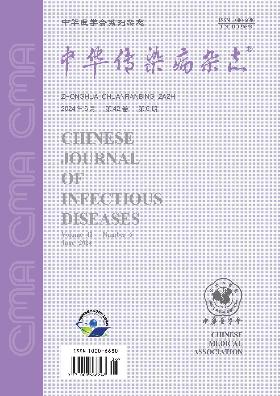Clinical features of 109 cases of novel coronavirus pneumonia
引用次数: 10
Abstract
Objective To observe theepidemiology, clinical manifestations, laboratory tests, imaging findings, treatment and prognosis of patients with novel coronavirus pneumonia. Methods Clinical data of 109 patients with suspected and definite novel coronavirus pneumonia admitted to Wuhan Sixth Hospital from December 24, 2019 to January 28, 2020 were retrospectively analyzed. Statistical analysiswas performed by using t test or chi-square test. Results Among the 109 patients, 48 (44%) were male and 61 (56%) were female, with the average age of (52.5±10.8) years. Fifty-four patients (49.5%) had definite contact history. Among the 109 patients, 104 (95.5%) presentedwith fever, 37(33.7%) with headache, 78 (71.9%) with general pain, 88 (80.8%) with fatigue and poor appetite, 23 (21.3%) with diarrhea, 94 (86.5%) withcoughing, 23 (21.3%) with shortness of breath, 57 (52.8%) withpalpitation, 45 (41.5%) with chest distress, 4 (3.3%) with chest pain, 40 (37.0%) with lung rales. Forty-two cases (38.5%) had leukocyte count 230 mmol/L, 29 cases (26.6%) had brain natriuretic peptide precursor>300 ng/mL, 87 cases (79.8%) had hypersensitive C-reactive protein >10mg/L, 26 cases (23.9%) had D-dimer >0.5 mg/L, 35 cases (32.1%) had coagulation disorder. The leukocyte counts, LDH, brain natriuretic peptide precursor and D-dimer of severe/critical cases[(11.33±4.87)×109/L, (527.51±260.87) mmol/L, (722.88±189.56) ng/mL, (1.89±4.24) mg/L, respectively] were all significantly higher than those of common cases [(4.02±1.49)×109/L, (159.75±30.31)mmol/L, (428.22±124.76)ng/mLand (0.41±0.22)mg/L, respectively], while the lymphocyte count of severe/critical cases [(0.60±0.17)×109/L] was significantly lower than common cases [(1.13±0.43)×109/L] (t=11.36, 11.33,9.81,2.81 and 7.77,all P<0.05). On admission, chest CT showed that 27 cases (24.8%) of pneumonia were unilateral, 82 cases (75.2%) werebilateral, and most of them were ground glass. The pneumonia progressed in a short time and reached the peak within 10 days. The comprehensive treatment included antiviral drugs, prevention ofbacterialinfection and supportive treatment, and glucocorticoid and respiratory support treatment wereadministrated when necessary. Conclusions The novel coronavirus pneumonia is characterized by highly infectious, rapid progress, and diverse clinical and imaging features. Early diagnosis and active comprehensive treatment could improve theprognosis and reduce themortality. Key words: Coronaviru infection; Pneumonia; Coronavirus disease 2019; Clinical characteristics新型冠状病毒肺炎109例临床特点
目的观察新型冠状病毒肺炎的流行病学、临床表现、实验室检查、影像学表现、治疗及预后。方法回顾性分析2019年12月24日至2020年1月28日武汉市第六医院收治的109例疑似和确诊新型冠状病毒肺炎患者的临床资料。统计分析采用t检验或卡方检验。结果109例患者中,男性48例(44%),女性61例(56%),平均年龄(52.5±10.8)岁。54名患者(49.5%)有明确的接触史。109例患者中,发热104例(95.5%),头痛37例(33.7%),全身疼痛78例(71.9%),乏力食欲不振88例(80.8%),腹泻23例(21.3%),咳嗽94例(86.5%),气短23例(213%),心悸57例(52.8%),胸痛45例(41.5%),胸痛4例(3.3%),肺部啰音40例(37.0%)。42例(38.5%)白细胞计数230mmol/L,29例(26.6%)脑钠肽前体>300ng/mL,87例(79.8%)超敏C反应蛋白>10mg/L,26例(23.9%)D-二聚体>0.5mg/L,35例(32.1%)凝血障碍。重症/危重病例的白细胞计数、LDH、脑钠尿肽前体和D-二聚体[分别为(11.33±4.87)×109/L、(527.51±260.87)mmol/L、(722.88±189.56)ng/mL、(1.89±4.24)mg/L]均显著高于普通病例[分别为:(4.02±1.49)×109g/L、(159.75±30.31)mmol/L和(428.22±124.76)ng/mL],重症/危重病例淋巴细胞计数[(0.60±0.17)×109/L]明显低于普通病例[(1.13±0.43)×109[L](t=11.36,11.33,9.81,2.81和7.77,均P<0.05)。肺炎在短时间内发展,并在10天内达到高峰。综合治疗包括抗病毒药物、预防细菌感染和支持治疗,必要时给予糖皮质激素和呼吸支持治疗。结论新型冠状病毒肺炎具有传染性强、进展快、临床和影像学特征多样等特点。早期诊断和积极的综合治疗可以改善患者的认知,降低死亡率。关键词:冠状病毒感染;肺炎;2019冠状病毒病;临床特征
本文章由计算机程序翻译,如有差异,请以英文原文为准。
求助全文
约1分钟内获得全文
求助全文
来源期刊
自引率
0.00%
发文量
5280
期刊介绍:
The Chinese Journal of Infectious Diseases was founded in February 1983. It is an academic journal on infectious diseases supervised by the China Association for Science and Technology, sponsored by the Chinese Medical Association, and hosted by the Shanghai Medical Association. The journal targets infectious disease physicians as its main readers, taking into account physicians of other interdisciplinary disciplines, and timely reports on leading scientific research results and clinical diagnosis and treatment experience in the field of infectious diseases, as well as basic theoretical research that has a guiding role in the clinical practice of infectious diseases and is closely integrated with the actual clinical practice of infectious diseases. Columns include reviews (including editor-in-chief reviews), expert lectures, consensus and guidelines (including interpretations), monographs, short monographs, academic debates, epidemic news, international dynamics, case reports, reviews, lectures, meeting minutes, etc.

 求助内容:
求助内容: 应助结果提醒方式:
应助结果提醒方式:


